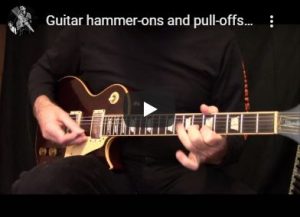Lead Guitar Made Easy. Over 150 Instant online guitar lessons

[ Sharps and flats ] [ Guitar Exercises ] [ Picking Exercise ] [ Guitar Tablature ] [ Guitar Tuning ]
Guitar Techniques including hammer-ons, pull-offs and bending
Guitar hammer-ons, pull-offs and bending guitar strings can really help add color
and speed to your lead guitar playing
Now that you have the A minor pentatonic scale in the root note fret memorized and have built up picking speed, we can move on to some Hammer-ons and other guitar picking techniques. Hammer-ons are a way of playing two or more notes on each string by picking the string only once. Hammer-ons help build speed and dexterity and add an unique sound to your scale improvising and runs. The image below shows a red line from the 1 to the 3 finger. Look at the image below.
Pick the C note on the 5th fret of the G string, 1 finger indicated by the red line. While holding that C note down with your 1 finger, hammer-on the 3 finger to the 7th fret indicated by the red line. You are now playing both of those notes, but only picking the G string one time. Once you practice this exercise, you can do the same thing with the 1-4 fingers on each string or any other notes you like.

|
|
Listen to a hammer-on from the Low E string, 5th fret, down to the high E string covering all the notes in the image below.
- Index finger
- Middle finger
- Ring finger
- pinkie

The fingering pattern to use for the pentatonic scale exercise above uses the fingering pattern of 1-4, 1-3, 1-3, 1-3, 1-4, 1-4. Look above at the image of pentatonic scale. Starting at the Low E string, play the 1 finger at the 5th fret and hammer down on the 8th fret with your 4 finger. Then move to the A string and hammer-on from 5th fret to the 7th fret using the 1-3 fingering. Make your way through the complete pentatonic scale from the Low E string to the high E string.
The next thing I would like for you to learn is the Pull-off. This time you would pick the 7th fret, 3 finger and pull off the 3 finger to the 1 finger that you have down on the 5th fret. Look at the image below.
Remember, you only have to pick the note on the G string one time to play both of these notes. Practice this pull off exercise up and down the guitar fretboard while playing the A minor pentatonic scale.
Play the D note on 7th fret of the G string indicted with the red 3 below. Have your 1 finger on the 5th fret of the G string indicated by the red 1. Pick the 3 finger and pull it off to the 1 finger. Kind of fret the note, then pull down slightly before letting go.
Listen to the Pull off starting at the A note, fret 5th fret, Low E string down through the complete scale to the high E string. See image above for each finger used.

The next thing I would like for you to learn is bending. Now this is really cool. The first bend will be a whole step bend. What do I mean by a whole step bend? This means bending the string to sound the note one whole step above that note. The whole step will equal two frets. For example, if you were to bend the A note a whole step, you would bend it up two frets to equal the sound of B note whole step about the A note.
Look at the image below. If you were to push up or bend the D note far enough, the tension on the string will change the pitch to a higher note. We want that D note, when bent to sound like the E note at the 5th fret, B string and the E note on 9th fret, G string. Both of those E notes should sound the same if you bend the string the proper distance. This does take time to learn.

Look at the D note on the 7th fret above. If you bend that D note on the G string far enough, it will sound the E note one whole step above. One whole step above would reach the E in Red and the E in purple. By the way, both of those E notes are the same, just in a different position. Whole steps, half steps, sharps, flats and tons more will be covered as we move along.
The way you bend the string is by picking the D note, 3 finger and then push that string up towards your chin. I find the easiest way to bend a string is by using two or all three fingers on the string to push it up. After you push up that D note, pick the E note in purple. The D note bent should sound like the E note a whole step above too. Practice the bend until you get the right sound from the D note and then we can move around the guitar fretboard later on.

I have included a bending example, but added one extra note, see the image above. I bent the D note, then pick the purple E and the black A note.
The images below show the A minor pentatonic scale at the 5th fret position. The first image shows the fingers use to play the scale. The second image shows the notes.


If you listen to these examples over and over, you will begin to hear what the notes should sound like. This will train your ear to pick leads out of recordings and begin to write your own songs.
In the video below, I’m using distortion on the electric guitar. I’m first bending the string, then playing hammer-ons and pull-offs.
|
|
Here’s the link to the video above if the video doesn’t load properly.
Here’s another guitar lick I’ve come up with. I really like this one, very unusual and original.
|
|
Here’s another guitar lick I’ve come up with. I really like this one, very unusual and original.
Use these blank illustrations to come up with other pentatonic scales. Use the hammer-on, pull-offs and bending for all the pentatonic scales.
Look at the illustration below. Notice that we used the same fingering pattern for the Bm pentatonic scale below as we did with the Am pentatonic scale above. We moved all the notes up 1 whole step. 1 whole step on the guitar equals two frets. The Bm pentatonic scale has the same notes as the D major pentatonic scale. The notes in the key of D major are: D E F# G A B C# D. Notice that the B note is the sixth note in the key of D major. This means that the B is the relative or natural minor scale in the key of D major. Bm and D major share the same key signature and have the same notes.
So, Am and C major share the same notes and Bm and D major share the same notes. This works for all scales. All major scales have a relative minor. In the major scale, the sixth note will be the relative minor.

For example, by moving this fingering pattern to the 12th fret, we would have the Em pentatonic scale. G major and Em share the same notes and key signature.

To figure out the minor pentatonic scale you take the major scale. For example, the notes in the key of C major are: C D E F G A B and C. We then take the sixth note of that scale, the sixth note will be the relative or natural minor of that major key. So, in C major the sixth note is the A note. We then write out the notes starting from that note. A B C D E F G and A. We know that the pentatonic scale only has 5 notes, so we must remove two of these notes.
The Am pentatonic scale will use the 1st note (A) 3rd note (C) 4th note (D) 5th note (E) and 7th note (G). This will then give us the notes of the Am pentatonic scale. A C D E and G. We know that Am pentatonic and C major pentatonic share the same notes. Am pentatonic, A C D E and G. C major pentatonic, C D E G and A.
So to figure out the major pentatonic scale, we take the major scale. We will use the key of C major to figure out the C major pentatonic scale. C D E F G A, B and C. We would take the 1st C, 2nd D, 3rd E, 5th G and 6th A. This would give us the notes of C major pentatonic, C D E G and A.
This works the same for all keys. One more example in the key of G major. The notes in the key of G major are: G A B C D E, F# and G. To construct the G major pentatonic scale, we would use the 1st G, 2nd A, 3rd B, 5th D and 6th E. G A B D and E.
Em is the relative minor in the key of G major. They share the same notes and key signature. Take the notes in the key of G major, but start with the E note. E F# G A B C D and E. We would use the 1st, 3rd, 4th, 5th and 7th notes for the Em pentatonic scale. E G A B D. It’s really all mathematical. We will learn much more about this topic in the guitar modes section.
Relative major pentatonic highlighted to the right.
| Am Pentatonic Notes | A | C | D | E | G |
| Bm Pentatonic Notes | B | D | E | F# | A |
| Cm Pentatonic Notes | C | Eb | F | G | Bb |
| C#m Pentatonic Notes | C# | E | F# | G# | B |
| Dm Pentatonic Notes | D | F | G | A | C |
| Em Pentatonic Notes | E | G | A | B | D |
Guitar Secrets


